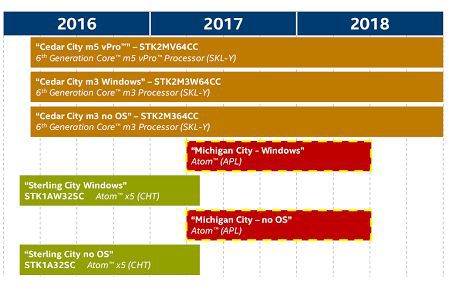Intel’s Compute Stick is basically a fully functional, low-power PC crammed into a device that looks like an oversized USB flash drive. Plug it into the HDMI port on a TV, connect a power source, and you can run Windows, Linux, or other operating systems on a TV, monitor, or commercial display.
So far, Intel has released models with Atom Bay Trail and Cherry Trail chips and pricier versions with Core M Skylake processors. Now a leaked product roadmap shows that the company is prepping its first Compute Sticks featuring Apollo Lake chips. They’ll likely be cheaper and less powerful than the Core M models, but significantly faster than any Atom-based Compute Sticks released to date.
According to the roadmap, Intel will release the new chips sometime around the second quarter of 2017, and they’ll feature Intel Atom chips based on the Apollo Lake architecture, which is a follow-up to the Cherry Trail and Braswell platforms that were used for low-power Atom, Celeron, and Pentium chips released in 2015 and 2016.
There will be at least two models:
- 2GB of RAM, 32GB of eMMC storage, Windows 10 64-bit software
- 4GB of RAM, 64GB of eMMC storage, no operating system
Both models will feature 802.11ac WiFi, Bluetooth 4.2 and USB 3.0 and USB 2.0 ports, as well as headset jacks, HDMI connectors, and HDMI-CEC support. They’ll come with one-year warranties.
Intel has largely phased out the Atom brand for its laptop, tablet, and smartphone chips, instead branding Apollo Lake chips for those platforms as Celeron or Pentium. But the company has released a few new Atom chips aimed at Internet of Things applications, including the Atom E3900 and Atom T5500 and T5700.
It’s not clear if Intel plans to use one of those chips for its next Compute Stick, or if the company has a different processor on the way. But what we know about those chips suggests that the new Atom T series chips could be up to 50 percent faster than Cherry Trail chips, support 4K video decoding and encoding, and support higher memory bandwidth, among other things. They’d also use up to twice as much power, though.
The E series chips include features for in-car computer, video surveillance systems, and other IoT products. If Intel is still positioning its Compute Stick devices as products for both consumer and enterprise customers, then the E series doesn’t seem like a great fit, but the chips could make sense if Intel envisions companies buying the sticks for commercial applications.
thanks Olivier!







